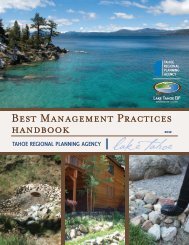4.1-d SUBSURFACE INFILTRATION SYSTEM ... - Tahoe BMP
4.1-d SUBSURFACE INFILTRATION SYSTEM ... - Tahoe BMP
4.1-d SUBSURFACE INFILTRATION SYSTEM ... - Tahoe BMP
You also want an ePaper? Increase the reach of your titles
YUMPU automatically turns print PDFs into web optimized ePapers that Google loves.
Subsurface Infiltration System Inspection and Maintenance Table<br />
INSPECTION AND MAINTENANCE ACTIVITIES<br />
SUGGESTED<br />
FREQUENCY<br />
INSPECTION<br />
EQUIPMENT<br />
MAINTENANCE<br />
EQUIPMENT<br />
Inspect for signs that stormwater runoff is properly accessing the infiltration feature. It may be necessary to<br />
pour water on the impervious surface the feature is designed to capture.<br />
• Repair any blocked or diverted conveyances.<br />
Inspect the feature for standing water.<br />
• If water has not fully infiltrated after 96 hours then rehabilitate the infiltration feature (described below).<br />
• Contact your local vector abatement office for specific instructions on controlling mosquitoes until<br />
rehabilitation can be performed.<br />
Inspect any inlets, pretreatment systems, and sediment traps for trash and debris (especially pine needles).<br />
• Remove trash and debris.<br />
For larger prefabricated installations, inspect all maintenance ports annually and record depths in a logbook.<br />
When accumulated material has decreased infiltration capacity by 30%, remove (e.g. vactor) accumulated<br />
material out of the infiltration facility.<br />
Inspect for upslope or adjacent contributing sediment sources to reduce the accumulation of sediment in<br />
the infiltration feature.<br />
• Stabilize contributing erosion and bare soil areas to prevent sediment entry into infiltration feature.<br />
Inspect for sediment and debris accumulation in the infiltration feature especially at the inlet.<br />
• If there is visual evidence of sediment at the top of the trench.<br />
• When dry, remove gravel, sieve gravel to remove sediment, clean or replace the underlying fabric, replace<br />
cleaned gravel and dispose of sediment in a TRPA approved stable on-site location or out of the Lake<br />
<strong>Tahoe</strong> Region.<br />
Inspect site for unusual or unsafe conditions (snowplow damage, structural damage, dumping, vandalism,<br />
etc.).<br />
• Repair structural components as necessary.<br />
Inspect infiltration feature for signs of compaction caused by vehicle traffic. Compaction will compromise<br />
performance and cause the feature to fail.<br />
• Rehabilitate infiltration feature to its designed Ksat rate.<br />
• Install parking barriers to exclude vehicle entry if signs of vehicle-caused compaction exist.<br />
Monitor ongoing effectiveness and determine whether another <strong>BMP</strong> type or additional <strong>BMP</strong>s could improve<br />
long-term effectiveness and improve benefits to costs versus the existing infiltration feature.<br />
• Analyze Inspection and Maintenance Log for trends and recurring issues.<br />
• Prepare a plan that more effectively addresses stormwater capture, reduces long term maintenance costs,<br />
and improves overall effectiveness and safety of the <strong>BMP</strong>.<br />
Before and during<br />
major storms<br />
96 hours after major<br />
storms<br />
Monthly<br />
(April—Oct)<br />
Annually<br />
Spring<br />
Semi-annually (spring<br />
and fall) and after<br />
major storms<br />
Annually in spring<br />
Annually in fall<br />
Every 5 years<br />
Water Source<br />
Stadia rod<br />
Shovel<br />
Qualified<br />
Inspector or<br />
Consultant<br />
Trash bag<br />
Shovel<br />
Tools suggested per<br />
qualified individual<br />
Leaf rake<br />
Trash bag<br />
Vactor Truck (for large<br />
installations)<br />
Soil Amendment,<br />
Seeds/Plants, Irrigation,<br />
Mulch, Erosion Control<br />
Blanket, Riprap, or<br />
Coir Logs<br />
Shovel<br />
Sieving Screen<br />
Trash Bag<br />
Tools as needed<br />
Parking barrier<br />
Installation tools<br />
Qualified Inspector or<br />
Consultant<br />
CHAPTER 4: <strong>BMP</strong> Toolkit<br />
TRPA <strong>BMP</strong> Handbook<br />
<strong>4.1</strong>-d SubSurface Infiltration System May 2014<br />
Page 32
















